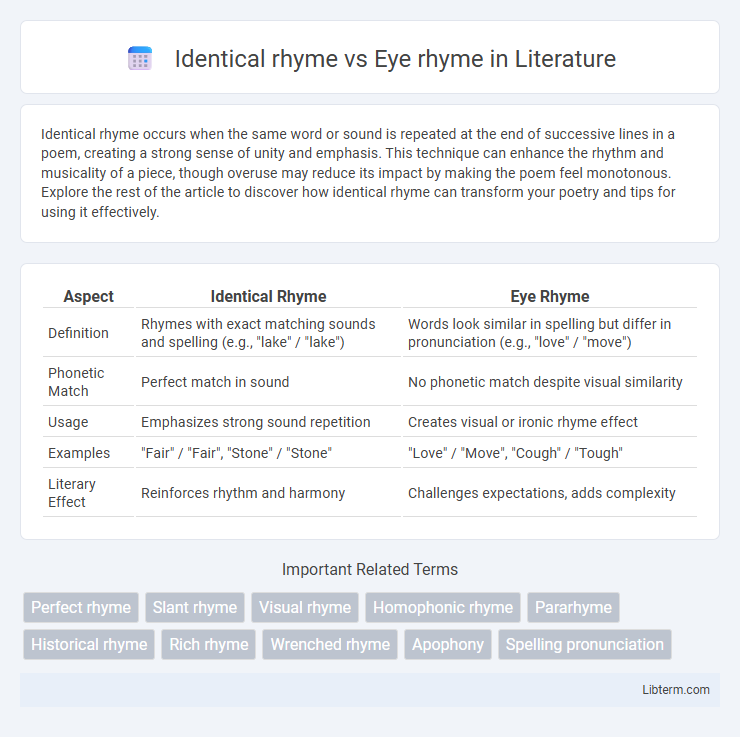Identical rhyme occurs when the same word or sound is repeated at the end of successive lines in a poem, creating a strong sense of unity and emphasis. This technique can enhance the rhythm and musicality of a piece, though overuse may reduce its impact by making the poem feel monotonous. Explore the rest of the article to discover how identical rhyme can transform your poetry and tips for using it effectively.
Table of Comparison
| Aspect | Identical Rhyme | Eye Rhyme |
|---|---|---|
| Definition | Rhymes with exact matching sounds and spelling (e.g., "lake" / "lake") | Words look similar in spelling but differ in pronunciation (e.g., "love" / "move") |
| Phonetic Match | Perfect match in sound | No phonetic match despite visual similarity |
| Usage | Emphasizes strong sound repetition | Creates visual or ironic rhyme effect |
| Examples | "Fair" / "Fair", "Stone" / "Stone" | "Love" / "Move", "Cough" / "Tough" |
| Literary Effect | Reinforces rhythm and harmony | Challenges expectations, adds complexity |
Understanding Rhyme in Poetry
Identical rhyme involves the repetition of the exact same word or sound, creating a precise match in pronunciation and spelling, which reinforces rhythm and cohesion in poetry. Eye rhyme occurs when words appear similar in spelling but differ in pronunciation, such as "love" and "move," challenging readers to recognize visual alignment despite phonetic divergence. Understanding these rhyme types enhances appreciation of poetic devices, as poets use them to produce varied auditory effects and deepen interpretive layers.
What Is Identical Rhyme?
Identical rhyme occurs when the same word or a homophone repeats at the end of two or more lines, producing a perfect sound match that intensifies the poem's rhythm and coherence. Unlike eye rhyme, which appears similar in spelling but differs in pronunciation, identical rhyme relies on exact phonetic repetition to create harmony within verse. This poetic device enhances memorability and emphasizes key themes by reinforcing sound patterns in close proximity.
What Is Eye Rhyme?
Eye rhyme occurs when two words appear to rhyme because of their spelling but do not sound alike, such as "love" and "move." This visual similarity contrasts with identical rhyme, where both the spelling and pronunciation of the rhyming words are exactly the same, like "cat" and "cat." Eye rhyme plays a unique role in poetry by creating subtle visual connections without relying on phonetic matching.
Key Differences Between Identical and Eye Rhymes
Identical rhymes occur when words share the exact same sound, such as "cat" and "cat," creating perfect phonetic repetition, while eye rhymes consist of words that look similar in spelling but differ in pronunciation, like "love" and "move." The key difference lies in phonetic accuracy; identical rhymes provide precise sound matching, whereas eye rhymes rely on visual similarity without sound correspondence. These distinctions affect poetic rhythm and reader expectation, as identical rhymes reinforce auditory patterns, while eye rhymes challenge conventional rhyme schemes through visual illusion.
Examples of Identical Rhyme
Identical rhyme occurs when the exact same word or sound is repeated, such as "night" and "night," creating a perfect auditory match. Common examples include "rain" and "rain," or "see" and "see," showcasing exact repetition for emphasis or rhythm. This differs from eye rhyme, where words like "love" and "move" look similar but do not sound the same.
Examples of Eye Rhyme
Eye rhyme involves words that look like they should rhyme based on spelling but do not rhyme when spoken, such as "love" and "move" or "cough" and "bough." These examples highlight the discrepancy between orthography and pronunciation, common in English poetry and song lyrics. Identical rhyme, by contrast, uses the exact same word or sound, like "day" and "day," emphasizing perfect auditory repetition.
Historical Use of Eye and Identical Rhymes in Literature
Eye rhymes, often called visual rhymes, have been used historically in English poetry as early as the 16th century, notably by Shakespeare, whose plays and sonnets exploit spelling-based rhymes like "love" and "prove" to create visual but not phonetic correspondence. Identical rhymes, where words match exactly in sound, have dominated traditional rhyme schemes across poetic eras, offering clarity and auditory harmony preferred from Chaucer's Middle English verse to modern poetry. Historically, eye rhymes reflect the evolution of English spelling and pronunciation, highlighting textual aesthetics, while identical rhymes prioritize sonic unity and rhythmic cohesion in literary compositions.
Impact on Poetic Sound and Meaning
Identical rhyme, featuring exact repetition of sounds and often words, strengthens the musicality and reinforces thematic elements by creating a predictable, harmonious pattern. Eye rhyme, where words look similar but sound different, challenges listener expectations, adding complexity and subtlety to the poem's tone and meaning. The interplay of identical and eye rhymes can enhance a poem's auditory texture while deepening interpretive layers by contrasting phonetic and visual cues.
Advantages and Challenges of Each Rhyme Type
Identical rhyme ensures perfect sound repetition, enhancing musicality and memorability in poetry, but risks monotony and reduced lexical variety. Eye rhyme creates visual similarity without exact sound matches, enriching poetic texture and allowing subtle phonetic play, yet it may confuse readers and weaken auditory impact. Balancing these rhyme types optimizes poetic aesthetic, catering to both visual appeal and sonic harmony.
Choosing the Right Rhyme for Your Poem
Identical rhyme uses exactly the same words or sounds, creating a strong echo effect, while eye rhyme relies on similar spelling but different pronunciations, adding subtle complexity to your verse. Choosing the right rhyme depends on your poem's tone and rhythm; identical rhymes emphasize musicality and cohesion, whereas eye rhymes invite readers to engage with deeper layers of meaning. Incorporate identical rhymes for clarity and impact, but use eye rhymes to evoke ambiguity or to challenge conventional rhyme schemes.
Identical rhyme Infographic

 libterm.com
libterm.com